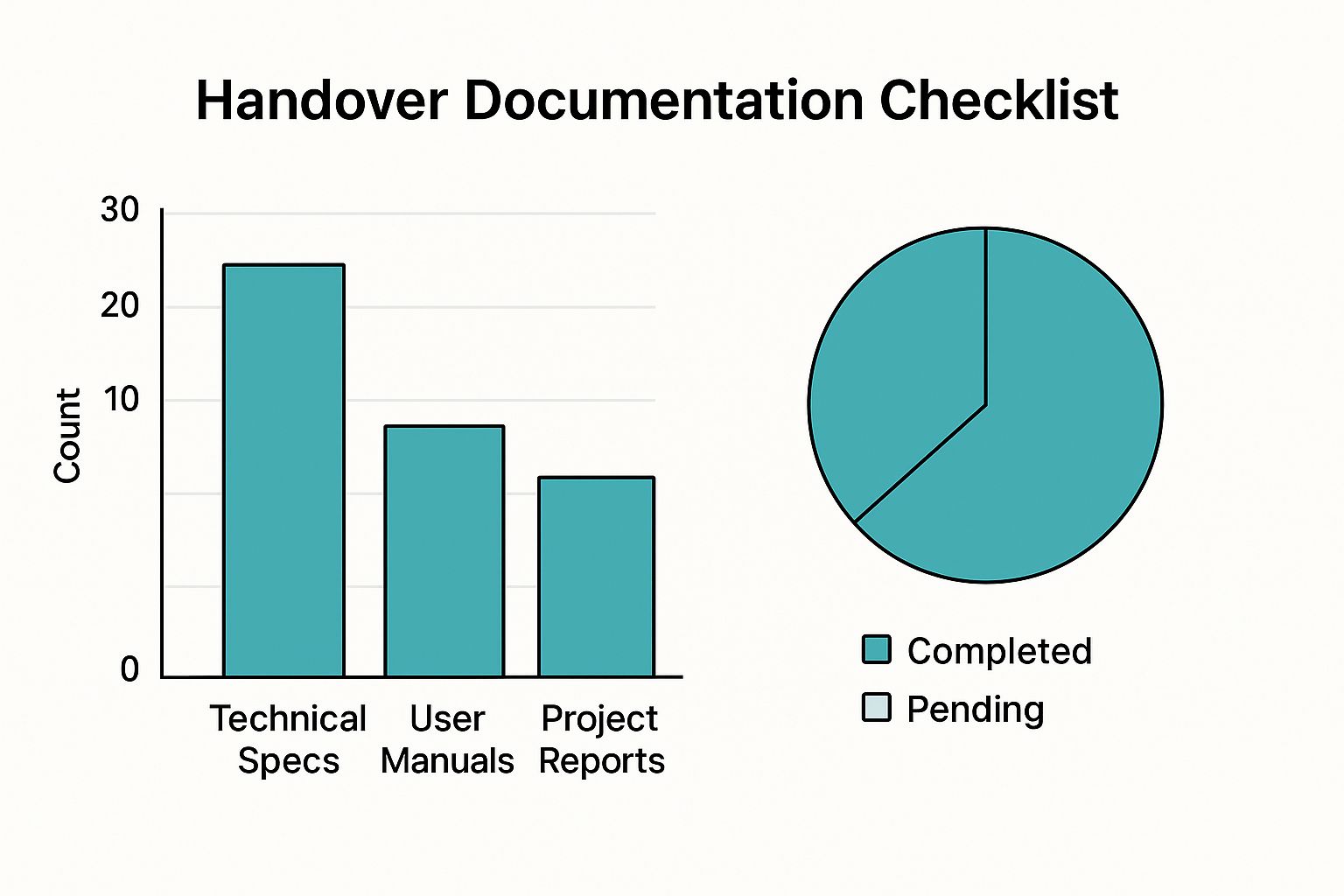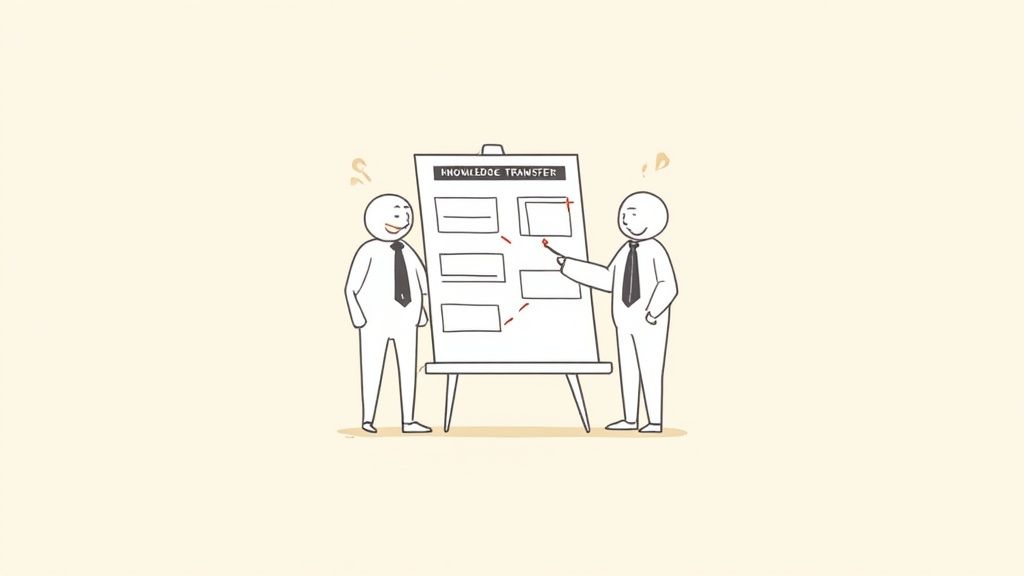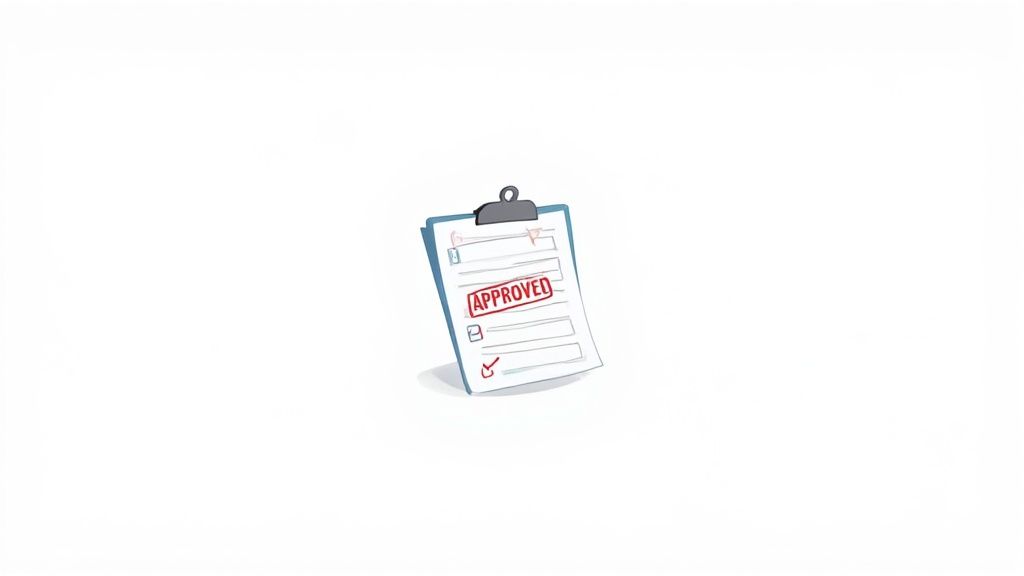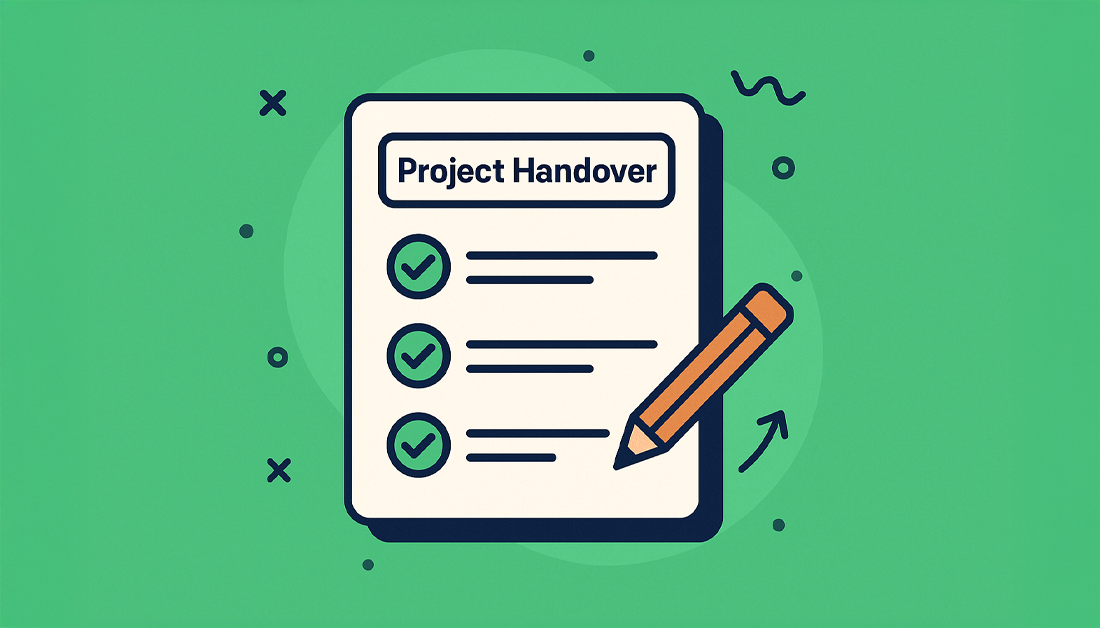Why Most Project Handovers Fail (And How Yours Won't)

Project handovers can be stressful. Instead of a smooth transition, many project managers find themselves facing unexpected chaos. This can negatively impact everything from team morale to the project's overall success. But why are so many handovers problematic?
Common Reasons for Handover Failures
Often, the root cause is a lack of structure. Think of baking a cake without a recipe. You might have the ingredients, but without clear instructions, the outcome is unpredictable. A project handover without a project handover checklist template is similarly destined for trouble.
This lack of structure can lead to several issues:
- Lost Institutional Knowledge: When team members leave, vital information can disappear, leaving the new team struggling to catch up.
- Frustrated Stakeholders: Poor communication and missed deadlines damage stakeholder trust and create unnecessary frustration.
- Delayed Project Benefits: A difficult transition can delay the project's positive impacts, ultimately affecting the return on investment (ROI).
For instance, imagine handing over a software development project to a maintenance team without proper documentation. The team might struggle to understand the code, resulting in delays for bug fixes and updates.
Poor stakeholder communication during the handover can also cause misunderstandings about the project's status and future direction. This can strain relationships and hinder progress. The importance of a project handover checklist is especially clear with the rise of complex IT projects. Studies indicate that about 70% of companies see improved project continuity and reduced risks when using these checklists. Checklists help transfer key project details, such as scope, schedule, and budget, as well as important contracts or agreements. Documenting attempted fixes and roadblocks can also reduce project delays by up to 30%. Learn more about IT project handover checklists: IT Project Handover Checklist – 8 Steps for a Seamless Transition
Setting Your Project Up for Success
A well-planned handover can transform a potentially chaotic process into a smooth transition. A project handover checklist template provides the structure needed to ensure that all essential information is addressed. This equips the new team with the resources they need for success, safeguarding the project's value and setting the stage for continued positive outcomes. Careful handover planning is more than just a best practice—it's a hallmark of effective project management.
Key Takeaways
- Structure is essential: A project handover checklist template helps avoid common handover problems.
- Knowledge transfer is paramount: Ensure a smooth transfer of information and expertise to the new team.
- Stakeholder communication is crucial: Keep stakeholders informed throughout the handover.
- Planning prevents problems: A proactive, structured approach is essential for handover success.
By focusing on these areas, you can create a seamless transition, maximize project value, and avoid the common issues that often plague project handovers. This understanding is fundamental to creating an effective project handover checklist template, a topic we'll cover in the next section.
Building Your Project Handover Checklist Template That Works
Now let's talk about creating a project handover checklist template that your teams will actually use. We'll explore the essential parts of every effective checklist, from figuring out who's involved to the specific documents you'll need. By looking at templates used by successful teams, we can discover how to structure your checklist so it's easy to use and doesn't overwhelm busy team members.
Essential Components of a Project Handover Checklist Template
Different projects need different approaches. What's right for software development won't necessarily work for marketing campaigns or construction projects. Customization is key.
-
Stakeholder Mapping: Figure out everyone involved and what they do. This makes sure everyone gets the right information at the right time.
-
Technical Documentation: Clearly document all the technical details, user manuals, and other important information. This is especially critical for IT projects to prevent future confusion and costly rework.
-
Project Timeline and Milestones: Lay out the project's history, including important dates and milestones reached. This gives valuable background to the team taking over.
-
Legal and Contractual Obligations: Include any relevant legal or contractual agreements to make sure everything's above board and prevent future disagreements.
-
Open Issues and Action Items: Clearly list any unresolved issues or unfinished tasks, assigning responsibility for finishing them. This encourages accountability and prevents things from slipping through the cracks.
To illustrate the importance of a well-structured handover, let's take a look at the following table which breaks down the crucial elements you should consider when creating your template:
To help visualize how these components apply to different project types, the table below offers a comparison across various industries, highlighting the importance and priority of each element.
Essential Components of Project Handover Templates
Comparison of critical elements across different project types and industries
| Component | IT Projects | Construction | Marketing | Priority Level |
|---|---|---|---|---|
| Stakeholder Mapping | Detailed list of developers, testers, project managers, and clients | Architects, engineers, contractors, subcontractors, and clients | Marketing team, sales team, clients, and agencies | High |
| Technical Documentation | Code documentation, API specifications, testing reports, deployment guides | Blueprints, structural calculations, material specifications, safety reports | Campaign strategy, creative assets, analytics reports | High |
| Project Timeline & Milestones | Sprint reports, release notes, bug tracking logs | Construction schedule, inspection reports, milestone completion certificates | Campaign timeline, key performance indicators (KPIs), budget tracking | Medium |
| Legal & Contractual Obligations | Software licenses, data privacy agreements, service level agreements (SLAs) | Building permits, construction contracts, insurance policies | Advertising regulations, intellectual property rights | High |
| Open Issues & Action Items | Bug fixes, feature requests, documentation updates | Punch list items, warranty claims, as-built drawings | Campaign optimization, follow-up activities | Medium |
This table shows how each component plays a different role depending on the industry. While technical documentation remains a high priority across all sectors, the specific details within that documentation vary significantly. Understanding these nuances is crucial for a smooth handover.

The infographic above visualizes the status of handover documentation, showing both the number of different document types and how complete they are. It clearly shows that while technical specifications and user manuals are available, project reports are lagging, indicating a potential area for attention before the handover is finished.
Customizing Your Template for Different Project Types
Think about the specific needs of different project types when creating or adapting your template.
-
Software Development: Focus on things like documenting code, testing processes, and setting up the right environment. Read also: How to master product backlog prioritization techniques
-
Marketing Campaigns: Focus on performance data, audience analysis, and creative materials.
-
Construction Projects: Focus on safety rules, blueprints, and material specifications.
Adapting your project handover checklist template to the project ensures that all the important information is captured and shared effectively.
Scalable Approaches for Growing Organizations
As your organization grows, your handover processes must grow with it. Building a scalable project handover checklist template involves:
-
Modular Design: Create reusable sections that can be combined and customized for different projects. This promotes consistency and avoids repetition.
-
Centralized Repository: Store templates in a central place accessible to everyone. This makes sure everyone uses the newest version.
-
Version Control: Keep track of template versions to keep a history of changes and maintain consistency.
-
Automated Workflows: Connect your checklist with project management software to automate tasks and make the handover process smoother.
Practical Guidance for Intuitive Templates
Making a checklist people actually use involves more than just the right parts. The template must be easy to use and understand. This means:
-
Clear and Concise Language: Use simple language everyone understands, avoiding technical terms whenever possible.
-
Visual Hierarchy: Use headings, subheadings, bullet points, and other formatting to make the checklist easy to read and understand.
-
Logical Flow: Organize the checklist in an order that makes sense for the handover process.
-
Built-in Prompts: Include prompts and questions to help people complete the checklist thoroughly.
Integrating the checklist into current workflows helps ensure its adoption and consistency. Using project handover templates improves project outcomes. In some cases, linking checklists to formal plans requiring signatures can increase accountability and compliance by up to 90%. About 80% of project managers report better communication and collaboration with standardized templates. Including meeting minutes and past project data can reduce post-handover problems by 25%. Learn more: The Project Handover Checklist. By focusing on usability and integration, even busy teams will follow your project handover checklist template, leading to smoother transitions and more successful projects.
Mastering Knowledge Transfer Without Losing Your Mind

Project handovers often present a significant challenge: transferring undocumented knowledge. This "tribal knowledge," residing within individual team members' minds, can be difficult to capture. We'll explore practical strategies for documenting everything from informal processes to information that never made it into official records. We'll also address situations involving unexpected departures or team members reluctant to share their expertise.
Effective Knowledge Transfer Sessions
Effective knowledge transfer sessions are crucial for successful project management. These sessions go beyond simple "brain dumps" that can overwhelm recipients. Instead, a structured approach is key.
-
Start with a clear objective. Define the specific information needing transfer.
-
Break down complex information. Visual aids, like process maps and diagrams, simplify complex systems. For example, visualize a complex approval workflow with a flowchart instead of a dense written explanation.
-
Engage the team. Foster interaction and Q&A instead of just lecturing.
-
Record the sessions. Create a valuable, reviewable resource, especially useful if team members leave. For further insights on delegation, check out this helpful resource: How to delegate tasks effectively.
Choosing the Right Documentation Format
Different information requires different documentation formats. While a project handover checklist template provides a solid starting point, consider various options:
-
Written Documentation: Ideal for processes, guidelines, and technical specifications.
-
Video Tutorials: Great for demonstrating software or complex procedures.
-
Interactive FAQs: Useful for addressing common questions and providing quick access to key information.
Ensuring Critical Information Doesn't Get Lost
A comprehensive project handover checklist template includes checks to prevent knowledge loss during team transitions. These checklists have significantly evolved over the past decade due to increasing project complexity. A 2015 study found that detailed documentation can reduce project restart times by up to 50%. For larger projects, formal project handover plans with sign-offs are now common, especially when requiring formal approval, resulting in a 60% reduction in post-handover issue resolution time. Furthermore, using tools like Jira or Trello allows for prioritizing handover tasks based on urgency and impact. For more information, see: the importance of project handover documentation.
Addressing Challenges in Knowledge Sharing
Knowledge sharing isn't always easy. Some may see their expertise as job security, or simply be too busy. Here's how to address this:
-
Highlight the benefits. Explain how knowledge sharing benefits the team and organization.
-
Create a culture of knowledge sharing. Recognize and reward active participants.
-
Make it easy. Provide clear guidelines and templates to simplify documentation, making it less burdensome and contributing to a more robust project handover checklist template.
-
Address resistance directly. Discuss reasons for reluctance and explore solutions.
By proactively addressing these challenges, project managers can preserve and effectively transfer valuable knowledge, contributing to long-term project success.
Getting Stakeholder Buy-In Without The Politics
Project handovers often require careful stakeholder management. You need approvals and engagement, but navigating organizational politics can be a challenge. This section offers strategies for identifying key stakeholders, communicating effectively, and overcoming resistance. The ultimate goal? Ensuring your project handover checklist template is adopted and used effectively.
Identifying Key Stakeholders: Who Really Needs to Be Involved?
It's crucial to differentiate between stakeholders who must be involved and those who believe they should be. Concentrate on individuals directly affected by the handover or whose contributions are essential for a smooth transition.
For instance, in a software project handover, the development team, the testing team, and the maintenance team are all key stakeholders. The marketing team, while interested, may not need to be directly involved in the technical details of the handover.
Communication Strategies: Keeping Everyone Informed Without Overwhelm
Effective communication keeps stakeholders informed without overwhelming them with unnecessary details. Tailor your communication to each stakeholder group, focusing on relevant information.
Employ diverse communication methods, including regular updates, targeted emails, and presentations, to keep everyone in the loop. For instance, provide the technical team with detailed documentation on the codebase, while offering management a high-level overview of the transition timeline and important milestones. Learn more about effective communication strategies in this insightful article: All About Client Onboarding Strategies.
Handling Resistance: Turning Skeptics into Supporters
Some stakeholders might view handovers as unnecessary overhead. To address this resistance:
-
Demonstrate the value: Show how a structured handover minimizes disruptions, preserves valuable knowledge, and safeguards the project's overall value.
-
Address concerns: Engage in open discussions about the reasons for resistance and offer solutions that work for everyone.
-
Share success stories: Provide real-world examples of how a well-executed handover has benefited similar projects or teams.
-
Offer training and support: Give teams the necessary tools and resources to embrace the new process, including a comprehensive project handover checklist template.
Approval Workflows: From Simple to Formal
The complexity of the project should determine your approval workflow. A simple email confirmation might suffice for smaller projects. Larger projects, however, may require a more formal sign-off process.
Regardless of your chosen approach, always document all approvals to ensure accountability and transparency. This documentation is a vital component of any robust project handover checklist template. Successful handovers often involve careful pre-handover planning, which includes:
-
Asset inventory: Documenting all project assets, including documentation, code, and access credentials.
-
Scope definition: Clearly outlining what is included and excluded in the handover.
-
Early communication: Keeping stakeholders informed about the handover process and timelines from the outset.
These practices contribute to a complete project handover checklist template and help secure stakeholder buy-in. Including these preparatory steps in the checklist itself underscores their importance and ensures consistency across different projects.
Implementing these strategies helps minimize political maneuvering and fosters a collaborative approach to the handover process. This leads to a smoother transition and increases the probability of long-term project success. With stakeholder buy-in secured, your project handover checklist template becomes an invaluable tool for a smooth and efficient transition.
Avoiding The Handover Disasters Everyone's Seen

Project handover disasters are, unfortunately, a common occurrence. They can range from software deployments that disrupt operations for weeks to construction projects missing crucial safety documentation. These failures often serve as cautionary tales, underscoring the importance of a well-structured project handover checklist template. This section examines these scenarios, providing actionable insights and highlighting the necessity of contingency planning and risk mitigation.
Learning From Real-World Handover Failures
Analyzing past failures can reveal common pitfalls to avoid. One example is a software deployment that led to weeks of operational disruption because of insufficient testing in the new environment. Another example is a construction project where essential safety information was never transferred, creating significant hazards.
Reviewing these situations emphasizes the need for thorough testing and validation within the project handover checklist template. This involves implementing checks for environment compatibility, data integrity, and comprehensive knowledge transfer. For example, including verification steps for access credentials, documentation review, and user training can prevent similar issues in the future. You might be interested in: A Client Onboarding Checklist for Success.
Early Warning Signs and Intervention Strategies
Recognizing when a handover is veering off course allows for timely intervention. Common warning signs include missed deadlines, communication breakdowns, and an increasing number of unresolved issues documented in the project handover checklist template.
Developing effective intervention strategies involves proactive communication, reassessing timelines, and potentially revisiting the scope of the handover. For example, if crucial documents are missing, adjusting the handover schedule to allow for their completion is necessary. Similarly, designating alternative contacts becomes vital if team members are unexpectedly unavailable.
Contingency Planning for Crisis Scenarios
Contingency plans are crucial for addressing common handover crises, such as key team members leaving mid-handover or the discovery of significant information gaps at the last minute.
A well-defined project handover checklist template incorporates contingency plans. This involves outlining backup procedures for knowledge transfer, specifying alternative communication methods, and establishing clear escalation paths for addressing critical issues. For instance, having documented knowledge repositories and designated backup personnel can ensure continuity if a key team member departs unexpectedly.
Risk Assessment and Mitigation
Effective project managers use risk assessment and mitigation frameworks to ensure smooth handovers. These frameworks identify potential risks, evaluate their likelihood and potential impact, and define mitigation strategies.
The following table provides an example of a simple risk assessment matrix:
To understand potential challenges and plan effective mitigation strategies, a risk assessment matrix is a valuable tool. The table below identifies some common risks, assesses their probability and impact, and outlines mitigation approaches.
Project Handover Risk Assessment Matrix
Common handover risks, their impact levels, and mitigation strategies
| Risk Factor | Probability | Impact | Mitigation Strategy | Success Rate |
|---|---|---|---|---|
| Incomplete Documentation | High | High | Implement a detailed documentation process and checklist | 80% |
| Key Personnel Loss | Medium | High | Create knowledge backups and cross-training procedures | 70% |
| Communication Breakdown | Medium | Medium | Establish clear communication channels and reporting protocols | 90% |
| Inadequate Testing | High | Medium | Implement rigorous testing procedures in the new environment | 85% |
| Delayed Approvals | Low | Low | Establish clear approval workflows and timelines | 95% |
This matrix allows project managers to prioritize mitigation efforts and ensures the project handover checklist template proactively addresses potential risks. By incorporating these strategies, project managers can avoid common handover pitfalls and improve the chances of a seamless and successful transition. This proactive approach transforms potential disasters into manageable challenges, protecting project value and ensuring long-term success.
Measuring Success and Getting Better Each Time
A successful project handover goes beyond simply checking off items on a project handover checklist template. It involves defining measurable success metrics and building a continuous improvement loop. This means actively analyzing the handover's effectiveness to ensure not only a smooth transition, but also the continuous evolution of your process.
Defining Success Metrics: What Truly Matters?
Defining the right success metrics helps determine whether the handover achieved its goals. These metrics should align with the project's overall objectives and consider both short-term and long-term impacts.
-
New Team Productivity: How quickly did the new team become productive? A slow ramp-up might suggest knowledge gaps or insufficient documentation. Tracking time to first successful deployment or the number of initial support tickets can offer valuable insights.
-
Stakeholder Satisfaction: Satisfied stakeholders are a key indicator of a successful transition. Post-handover surveys can gauge their experience and identify areas for improvement. Gather feedback on the clarity of documentation, the outgoing team’s responsiveness, and the overall transition experience.
-
Project Outcomes: Ultimately, a successful handover contributes to positive project outcomes. Tracking milestones, budget adherence, and client satisfaction post-handover provides valuable data for future projects. This connects the handover process directly to the project's long-term success.
Evaluation Methods: Gathering Actionable Insights
Gathering useful data requires appropriate evaluation methods. These methods provide feedback for refining your project handover checklist template and the overall handover process.
-
Post-Handover Surveys: Surveys offer a structured approach to collecting feedback from both the outgoing and incoming teams. Ask specific questions about the handover process, documentation clarity, and any challenges encountered.
-
Performance Tracking: Monitor the new team's performance. Track metrics such as task completion rates, bug fix times, and system uptime. This data can highlight lingering problems or areas needing additional support.
-
Feedback Sessions: Regularly hold feedback sessions with both teams. These sessions create an open forum for discussing successes, challenges, and potential improvements, enabling quick identification and resolution of issues. Learn more in our article about Jira Capacity Planning.
Creating a Learning Loop: Continuous Improvement
High-performing organizations see handovers as opportunities for continuous improvement. They establish learning loops by systematically analyzing each handover and documenting lessons learned.
-
Documenting Lessons Learned: Create a central repository for capturing lessons learned. This repository should be accessible to all project managers and updated regularly, becoming a valuable resource for future projects.
-
Updating Processes: Use insights from the learning loop to update your project handover checklist template and refine the process. Regularly review and adjust your approach based on this feedback.
-
Maintaining Organizational Memory: Preserving organizational memory is crucial, even with staff changes. Documenting processes, decisions, and lessons learned maintains valuable knowledge and ensures consistency across projects. This knowledge base becomes a vital part of a successful project handover checklist template.
By focusing on these key areas—defining success metrics, using effective evaluation methods, and establishing a continuous improvement loop—you can transform your project handovers from potentially stressful events into opportunities for organizational growth and greater project success.
Your Handover Implementation Roadmap
Transforming your organization's project handover process takes a structured approach. This roadmap provides a step-by-step guide for implementing your project handover checklist template, from initial pilot programs to full organizational adoption. It's designed to help you navigate the transition efficiently, minimize disruptions, and build a culture of smooth handovers.
Phase 1: Pilot Program and Early Adoption
Start with a pilot program involving a small group of projects and teams. This controlled environment lets you test your project handover checklist template, gather feedback, and refine the process before a wider rollout.
-
Select Pilot Projects: Choose projects with varying complexity and team structures to truly gauge the template's adaptability. A diverse pilot group offers a more realistic view of its effectiveness.
-
Train Pilot Teams: Conduct thorough training on using the checklist and emphasize its benefits. Explain how it streamlines transitions, minimizes errors, and improves overall project continuity.
-
Gather Feedback: Actively collect feedback from the pilot teams on the template's usability, completeness, and effectiveness. Use surveys, interviews, and dedicated feedback sessions for both quantitative and qualitative data. This iterative feedback is crucial for turning your template into a truly valuable tool.
-
Iterate and Refine: Based on the feedback received, adjust the checklist and its associated processes. You might add or remove sections, clarify language, or incorporate new tools and techniques. Think of your project handover checklist template as a living document that evolves and improves over time.
Phase 2: Expanding Reach and Building Momentum
After successful pilot testing, it's time to expand. Roll out the project handover checklist template to more teams and integrate it into your standard operating procedures.
-
Communicate Value: Clearly articulate the advantages of the standardized handover process to the wider teams. Sharing success stories from the pilot program can significantly encourage adoption.
-
Provide Support: Offer consistent support and training to new teams using the checklist. This might involve supplying resources, answering questions, and addressing any roadblocks they encounter. Continued support is key to maintaining positive momentum.
-
Integrate into Existing Workflows: Seamlessly integrate the project handover checklist template into your current project management workflows. This could involve incorporating it into project management software like Jira or setting up automated reminders and notifications.
-
Monitor and Measure: Keep track of usage and effectiveness using key metrics. Monitor the number of projects using the checklist, the completeness of handover documentation, and any reduction in post-handover problems.
Phase 3: Organizational Adoption and Continuous Improvement
This phase focuses on embedding the project handover checklist template into the organizational culture. It's about moving beyond simply using the checklist to genuinely embracing it as standard practice.
-
Champion the Process: Encourage project managers and team leaders to become active champions of the process. Their support and buy-in reinforces the checklist’s value within their teams.
-
Create a Knowledge Base: Develop a centralized knowledge base for best practices, templates, and resources related to handovers. This becomes an invaluable resource for teams throughout the project lifecycle.
-
Regular Review and Updates: Regularly review and update the project handover checklist template based on continued feedback and any organizational changes. This keeps the template relevant and efficient in the long run.
-
Celebrate Successes: Publicly acknowledge and celebrate teams that consistently use the checklist and achieve smooth handovers. This fosters a culture that values seamless transitions and highlights the positive impact of the new process.
By following this roadmap, you can successfully implement your project handover checklist template, minimize disruption, and cultivate a culture of seamless project handovers that contribute to greater project success.
Tired of handover headaches in Jira? resolution's Out of Office Assistant for Jira Cloud automates handovers and keeps workflows moving, even when team members are away. Learn more and start your free trial today: resolution Out of Office Assistant for Jira Cloud
